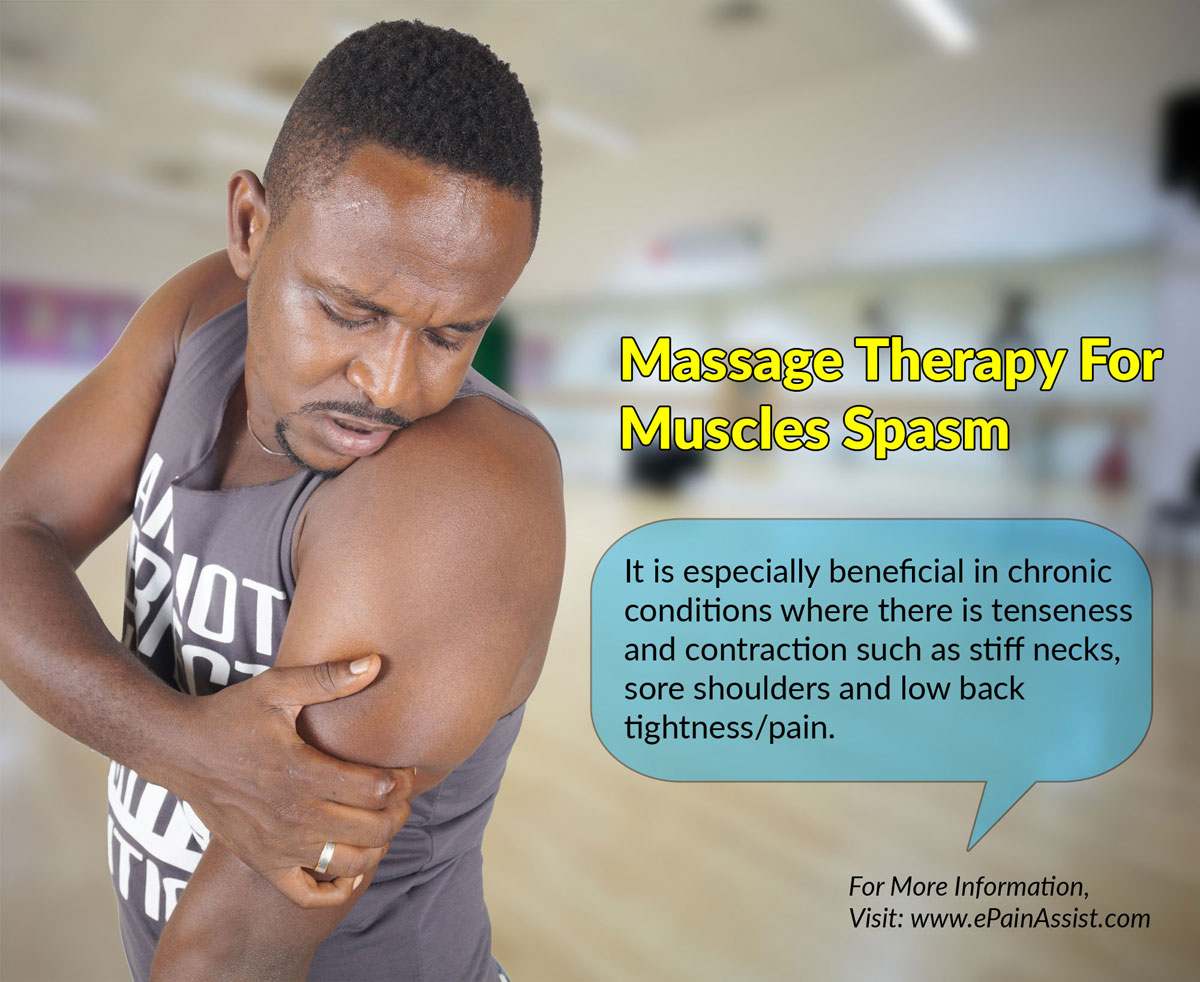Understanding Muscles and Spasm of The Muscles
A group of body tissues constitute the muscles. These muscles are attached to the bones and their function is helping in movements of body. Smooth functioning of the muscles, such as voluntary contraction, depends on the motor neurons of the nerves, calcium ions, and proteins present in the muscles. These things should be in the right balance for proper functioning of muscles. When the monotony harmony between these factors gets disturbed, it results in spasm of the muscle.
Massage for Muscle Spasm, Muscle Strain, and Muscle Pain
- The sites which are most commonly affected by muscle spasm are neck, arm legs, and back; however, any muscle in the body can also undergo a spasm.
- The first symptom in muscle spasm is pain followed by swelling and soreness.
- Patient is temporarily not able to move after the pain.
- Muscle spasm usually occurs as a result of fatigued muscles, such as occurring when performing activities requiring extreme exertion. Dehydration, diminished oxygen supply, muscle injury and electrolyte imbalances are some other reasons for muscle spasm.
Massage Benefits for Muscle Spasm, Strain and Pain
- Massage is one of the easiest treatments in muscle spasm for bringing back the normal contractility and function of the muscle.
- Massage done for muscle strain helps in improving flexibility, relaxing the muscle, and leaving the person feeling fresh and energetic.
- Massage therapy also helps in improving the blood and oxygen flow.
- Massage therapy enhances stamina and performance levels.
- Massage done for muscle strain decreases the chances of re-injury.
- Massage promotes the healing process.
Deep Tissue Massage for Muscle Spasm, Strain and Pain
Deep tissue massage is a form of massage therapy that aims in realigning the deeper muscle layers and connective tissue. It is especially beneficial in chronic conditions where there is tenseness and contraction such as stiff necks, sore shoulders and low back tightness/pain. When compared to a classic massage therapy, the movements of deep tissue massage are slower and applied with deeper pressure, which is focused on areas of pain and tension.
Deep Tissue Massage: How It Works on Muscles
Usually, chronic muscle injury or tension causes adhesions (bands of rigid and painful tissue) to form in the tendons, muscles and ligaments. These adhesions hinder the blood circulation and cause pain, inflammation and restricted movement. Deep tissue massage actually physically breaks down these adhesions thus relieving pain and restoring normal body movements. To achieve this, the massage therapist commonly uses direct and deep pressure or applies friction across the grain of the muscles.
Deep Tissue Massage: Pain and Discomfort in Muscles
Patients may experience pain and discomfort at certain stages of the deep tissue massage. If this is the case, the patient should immediately inform the massage therapist if the pain or discomfort is unbearable. Mostly, patients will have some pain or stiffness after a deep tissue massage is done; however, it should subside within 1 or 2 days. The massage therapist may also recommend ice application to the affected area after the massage.
Benefits of Deep Tissue Massage
Classic massage therapy is done for relaxation purpose, whereas deep tissue massage focuses on specific problems including:
- Chronic/prolonged pain.
- Restricted mobility.
- Recovery from injuries such as falls, whiplash or any sports injury.
- Fibromyalgia
- Problems with posture
- Repetitive strain injury, e.g. carpal tunnel syndrome.
- Muscle spasm or tension.
- Pain from osteoarthritis.
Deep Tissue Massage: Preparation
- Massage therapists commonly use their fingertips, knuckles, elbows, hands, and forearms to perform a deep tissue massage.
- Patient is asked to breathe deeply while massage therapist works on certain tense or tight spots.
- Patient should drink lots of water after the massage is done in order to flush out the metabolic waste from the tissues.
Contraindications to Massage
- If you are suffering from infectious rash, open wounds or infectious skin disease.
- If you are immediately post-op.
- After any radiation or chemotherapy, unless your oncologist has permitted it.
- Individuals suffering with osteoporosis should consult their primary care giver before a massage.
- If you are prone to blood clots.
- Pregnant/expecting mothers should consult with their doctor first before getting any massage done.
- Massage should never be done directly over inflamed skin, bruises, tumors unhealed wounds, abdominal hernia or in those regions where there has been a recent fracture.
- Never eat a heavy meal before a massage session.
Also Read:
- Q and A on Disabling Low Back Pain Due To Muscle Spasm or Tense Back Muscles or Facet Joint Pain
- Lower Back Muscle Spasms: Causes, Symptoms, Treatment
- Muscle Spasm: Causes, Symptoms, Treatment, Recovery
- What Causes Back Muscle Spasms or Sprain & What is its Treatment, Prevention
- How Long Do Back Spasms Last & What to Do For it?
- 7 Causes of Back Muscle Spasm & Its Risk Factors

